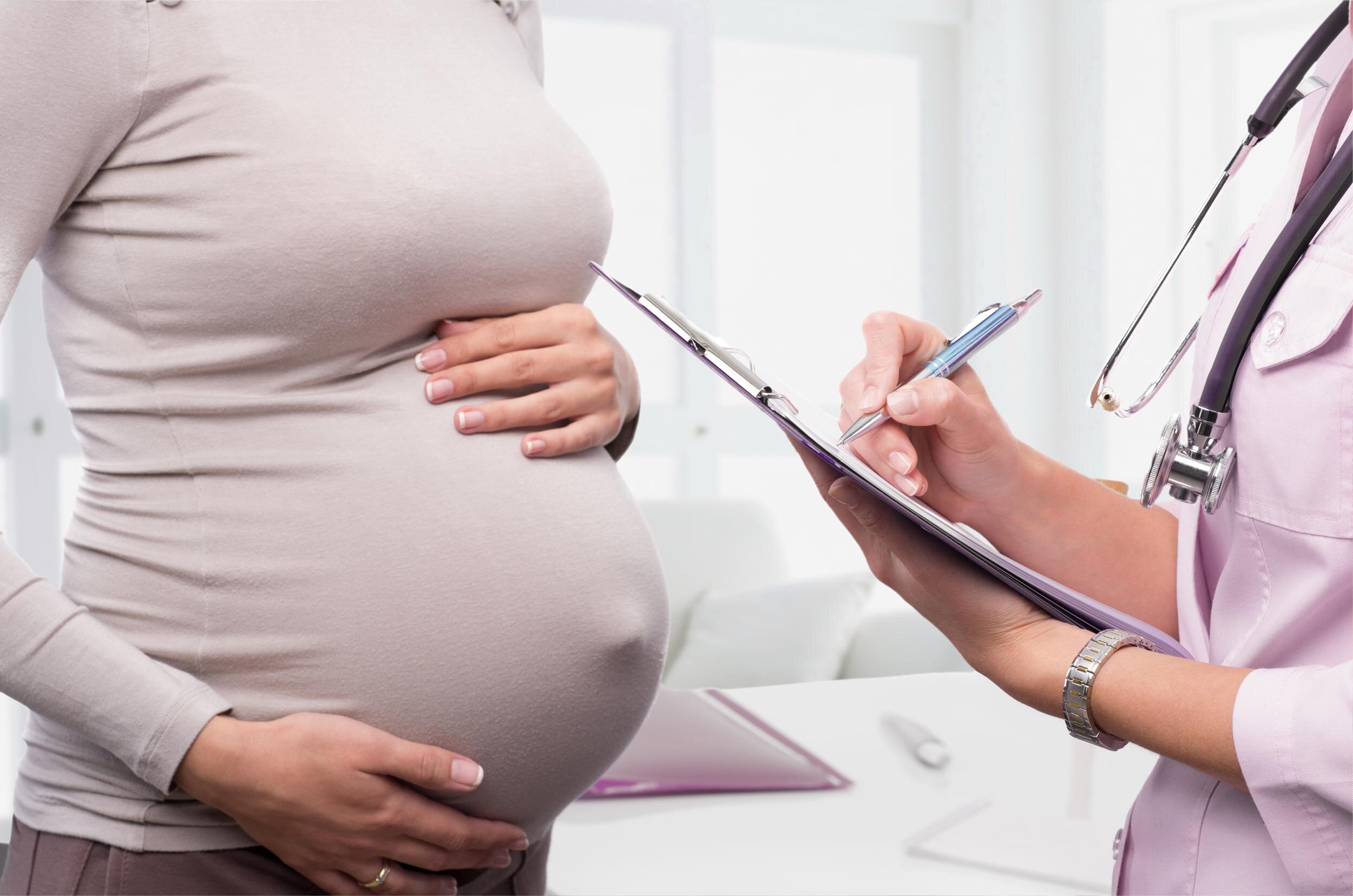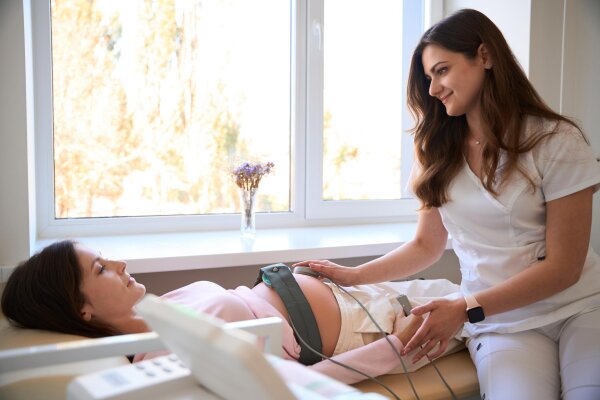Most mums-to-be will hear about CTG monitoring either during pregnancy or during labour. Cardiotocography (short: CTG) is used for recording the contractions in the mother’s uterus along with the baby’s heart rate.
During labour, cardiotocography is an important tool for monitoring the baby's well-being. The results provide information on how the unborn baby is reacting to the contractions and if the baby is in any kind of distress. In some cases, CTG monitoring is already performed during pregnancy. For instance, to monitor a high-risk pregnancy.
What is a CTG for pregnancy and labour used for? How does it work? When and why is it performed? How to interpret the results? Is CTG safe for babies? Read on as we answer all your questions.
Table of content
What is a CTG?
How does CTG monitoring work?
CTG scan measurements: How to read a CTG?
The role of CTG monitoring during labour
Prenatal CTG monitoring: when is a CTG scan done in pregnancy?
CTG for pregnancy: are there any disadvantages?
CTG for pregnancy and labour: facts at a glance
What is a CTG?
Cardiotocography (CTG for short) measures and records the baby's heartbeat and the strength of the contractions in the mother’s uterus. The device which is used to do this is called a cardiotocograph.
CTG can be used both during pregnancy and during labour. In the final weeks of pregnancy, cardiotocography is often used to monitor the baby's heart rate.
Interesting to know: The cardiotocograph was invented by the German gynaecologist and professor of medicine Konrad Hammacher. Before that, the only device available for listening to foetal heart sounds was the Pinard stethoscope which was pressed onto the mother's stomach during pregnancy.

How does CTG monitoring work?
Cardiotocography records uterine contractions and foetal heart rate at the same time. Together, these two recordings provide information about the baby's well-being. In some cases, foetal movements are also recorded to obtain a more holistic view of the baby’s state of health. This is then called kinetocardiotocography.
The baby’s heartbeat and the contractions in the mother’s womb are recorded using two different methods. The baby’s heart rate (and, if necessary, also baby movements) is recorded using ultrasound. This means that sound waves are sent to the baby's heart which are then reflected back and recorded by the ultrasound device.
Uterine contractions, on the other hand, are measured using a pressure-sensitive transducer that records changes in the tension of the mother's abdominal wall. The recordings allow the medical team to draw conclusions about the contractions happening in the uterus.
Both the ultrasound transducer and the pressure-sensitive transducer are fixed to the mother's abdomen using straps. The measurements are recorded in the form of a printout.
CTG scan measurements: How to read a CTG?
CTG monitoring in pregnancy delivers two different measurements which are then recorded on paper. One measurement is the foetal heart rate and the other one is the mother’s uterine contractions. Let’s look at how to interpret the results.
The baby’s heartbeat is assessed based on different parameters, including the baseline foetal heart rate, variability, accelerations and decelerations. By taking into account the different factors, the foetal heartbeat is classified as normal, suspicious or pathological. During labour, this classification serves as a reference point for midwives, obstetricians and doctors to assess the situation and adjust the medical care provided to the mother.
The second measurement which is assessed as part of the CTG is the toco measurement which records the duration, frequency, regularity and form of the contractions - always in relation to the baby's heartbeat. Together, the two measurements provide insights into the baby's well-being which healthcare professionals can use to assess the situation and mitigate potential risks for mother and baby.

The role of CTG monitoring during labour
Cardiotocography is an important monitoring tool during labour. The CTG shows the medical team whether the baby is okay or whether immediate action (e.g. induction of labour) is required to prevent possibly dangerous situations.
There are two different types of CTG monitoring during labour: intermittent monitoring and continuous monitoring. For low-risk pregnancies with an uncomplicated development, intermittent monitoring during labour is recommended.
In high-risk pregnancies, CTG monitoring is typically performed continuously. At the latest during the second stage of labour, cardiotocography is done without intermittency. Based on the baby's heart rate, healthcare professionals can check whether the baby is coping well and recognise signs of distress that could indicate impending complications.
In contrast to foetal heart rate, interpreting the toco values on the CTG trace is more difficult. The pressure-sensitive transducer records the frequency and length of the contractions in the mother’s uterus. However, depending on the mother’s physique, the CTG trace showing the contractions (also known as tocogram) might be less accurate. The interpretation of the tocogram is therefore only ever possible to a limited extent.
Interesting to know: Having the duration and length of their contractions displayed on paper is a fascinating thought for many women. But how to read contractions on a foetal monitor? While there are no fixed numbers or values, contractions typically appear as peaks in the tocogram.
Prenatal CTG monitoring: when is a CTG scan done in pregnancy?
Cardiotocography is primarily used to monitor uterine contractions and foetal heart rate during labour to assess the unborn baby’s well-being. However, a CTG can also be done during pregnancy.
Prenatal CTG monitoring is often indicated if antenatal screening tests have shown a condition or physical impairment in the baby or if the mother has a pre-existing health condition (e.g diabetes) or if there have been other pregnancy-related complications (e.g. pre-eclampsia). Therefore, the use of cardiotocography during pregnancy is often linked to the classification of the pregnancy as high risk.
Reasons why you might be offered CTG monitoring during pregnancy can include:
- impending premature birth
- abnormalities in the baby’s heartbeat detected during one of the antenatal care appointments
- bleeding during pregnancy
- reduced foetal movements
- twin pregnancy or multiple pregnancy
Good to know: How long does a CTG take during pregnancy? Future mothers often want to know how long the appointment for the scan will take. On average, the monitoring of the baby's heart rate takes around 30 minutes. Afterwards, the results are analysed by a healthcare professional.
CTG for pregnancy: are there any disadvantages?
Cardiotocography is considered a safe method of monitoring the baby's well-being during labour. Similar to ultrasound scans in pregnancy, it is not known to have any negative effects on mother or baby.
However, studies have shown that the use of cardiotocography during pregnancy or labour can result in doctors and obstetricians acting prematurely. For example, continuous CTG monitoring during labour is often associated with C-section.
This is due to the fact that healthcare professionals might misinterpret the CTG traces and wrongly assume that the baby’s well-being is at risk which leads to a surgical delivery. That’s why there should always be additional tests (usually blood tests during pregnancy) to get clarity.
CTG for pregnancy and labour: facts at a glance
- During a CTG, the mother's contractions (toco) and the baby's heart rate (cardio) are measured and recorded simultaneously. Hence the technical term ‘cardiotocography’.
- Cardiotocography plays an important role in monitoring the baby’s well-being during labour.
- If the mother has any pre-existing health conditions or if any abnormalities have been detected in the foetus during routine screening tests in pregnancy, a CTG can also be done during pregnancy.
- Although cardiotocography plays an important role in monitoring foetal well-being during labour, there are also some drawbacks. Incorrect interpretation of CTG results can lead to doctors and obstetricians rushing to perform a caesarean section without acute reason.
References
- Recommendations | Fetal monitoring in labour | Guidance | NICE
- intrapartum-fetal-monitoring-obstetrics.pdf (scot.nhs.uk)
- Intrapartum Fetal Monitoring Guideline (physiological-ctg.com)
- Cardiotocography (Baby heartbeat monitor during labour and delivery) (patient.info)
- wisdom.nhs.wales/health-board-guidelines/cwm-taf-maternity-file/fetal-monitoring-guideline/
- Geburtsüberwachung: Der Cardiotokograph (CTG): Vom Düsseldorfer Keller in die Welt" (idw-online.de)
- Kardiotokografie (CTG) - via medici (thieme.de)
- Kardiotokografie (CTG) » Diagnostik » Frauenärzte im Netz - Ihr Portal für Frauengesundheit und Frauenheilkunde » (frauenaerzte-im-netz.de)
- CTG: Das sagt der Wehenschreiber aus | Apotheken Umschau (apotheken-umschau.de)
- s00129-008-2286-620161121-9768-1qi7hgw-libre.pdf (d1wqtxts1xzle7.cloudfront.net)
- Richtlinie über die ärztliche Betreuung während der Schwangerschaft und nach der Geburt (g-ba.de)
- Kardiotokografie (CTG) - via medici (thieme.de)
- Das Potenzial erkennen (dhz-online.de)
- Kardiotokografie (CTG) - eRef, Thieme
- Schwangerschaft: Risiko und Nutzen sind je nach Vorsorgemaßnahme abzuwägen | ZEIT ONLINE


















